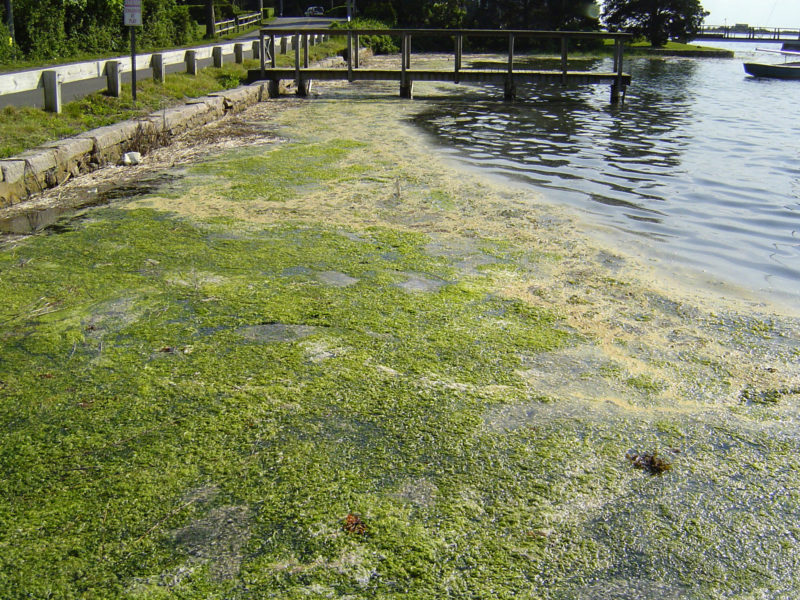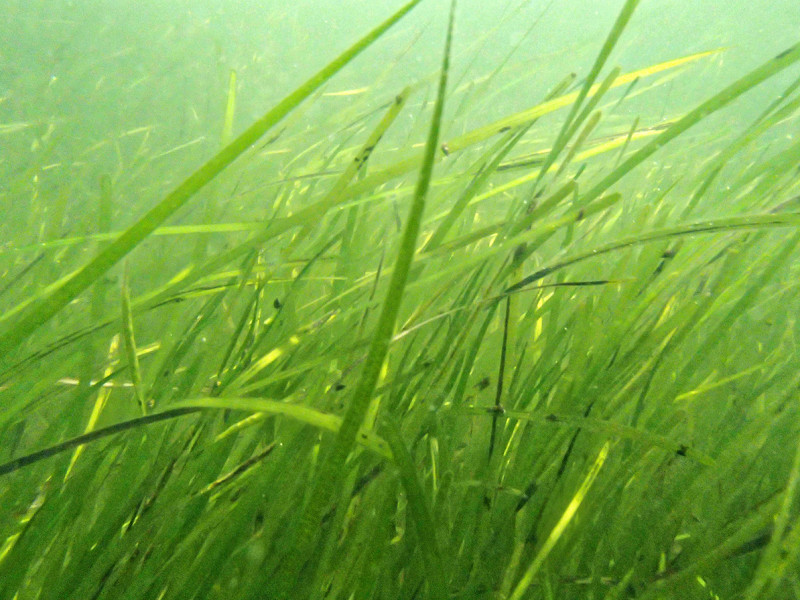‘Restoration of West Falmouth Harbor’ event leaves residents with hope, challenges
What Susan Garland remembers best are the fish. Kayaking in the 1980s along the Mashapaquit Creek, which spills out beside her family’s property on Chase Road before meeting West Falmouth Harbor, Ms. Garland remembers looking down through the water and being able to see straight to the bottom, her view obstructed only by hordes of small fish that glimmered silver as they turned.

Nitrogen pollution fuels the growth of algae blooms, like this one seen in West Falmouth Harbor in 2012.
Over the last four decades, however, Ms. Garland watched as the water clouded, as green “muck” began washing up on shore, and as seabirds and shorebirds and fish, too, seemed to disappear from the waters around West Falmouth Harbor.
That change is one of the reasons Ms. Garland, along with nearly 70 other West Falmouth residents, filed into the auditorium at Falmouth Academy’s Simon Center for the Arts on June 29 for a symposium on the last 25 years of science and policy around nitrogen-polluted West Falmouth Harbor. Despite the bright, hot June day outside, attendants of the Buzzards Bay Coalition-hosted event were there because they care deeply about what has happened to the harbor and what can be done to fix it.
Yet many came away finding that the answer was not exactly what they expected.
“For 20 years we’ve focused on the Falmouth wastewater treatment plant as the biggest nitrogen pollution source,” said Rachel Jakuba, the Coalition’s science director. “And while nitrogen from the plant has had, and is still having, a tremendous effect on the harbor, the plant itself isn’t the same level of threat anymore. The task of restoring West Falmouth Harbor has shifted.”
Falmouth’s wastewater has been treated by a facility on Blacksmith Shop Road since 1986. As in most wastewater treatment plants, the facility discharges water separated from waste, known as effluent. While cleaned of any harmful viruses or bacteria, for much of the plant’s history this effluent was very high in nitrogen.
That nitrogen seeped through the sand, rock and dirt around the treatment facility and entered the groundwater, where it began moving toward the harbor.
In the mid-1990s, scientists began seeing nitrogen levels spike in waters around West Falmouth—and with it, increased algae growth, along with sharply declining shellfish health, eelgrass coverage, and water quality. To this day, groundwater sampled around West Falmouth Harbor still has very high nitrogen levels.
However, the Blacksmith Shop Road facility took on a dramatic upgrade in 2005 that reduced the nitrogen load in its effluent. In the 1980s and 1990s, Falmouth’s effluent had nitrogen levels as high as 20 to 30 milligrams per liter (mg/L); today, nitrogen in its effluent hovers around 3 mg/L.
Why, then, are waters around West Falmouth Harbor still so nitrogen-rich? The answer is not a simple one.
“We’ve done a great job removing nitrogen from our treatment plan and improving performance there, but we haven’t seen this number move all the way down as far as we’d like to see [in groundwater]. And it’s a complicated picture,” explained Amy Lowell, Falmouth’s wastewater superintendent.
Researchers who met in a morning science session of the event at the Woods Hole Research Center, also hosted by the Buzzards Bay Coalition, found that their data agreed: the groundwater around Falmouth seems to move exceptionally slowly, even slower than expected. Previous estimates put groundwater speed in the area at around a foot or so per year; at that rate, researchers expected it would take around eight to 12 years for a plume of water to flush itself out of the groundwater. Yet it has been 13 years since Falmouth’s wastewater treatment plant was upgraded, and scientists are still waiting to see the improvements reflected in Falmouth’s groundwater.
Meanwhile, the most significant source of nitrogen in the area has changed. Today, it is septic systems in residential homes around West Falmouth Harbor.

If nitrogen levels drop in West Falmouth Harbor, residents should see the return of thick green eelgrass and healthy shellfish beds.
While they wait for the treatment plant’s “dirty plume” to flush out of West Falmouth’s groundwater, experts at the Buzzards Bay Coalition have turned their energy toward helping homeowners to convert outdated cesspools and septic tanks to nitrogen-reducing systems, which treat sewage to prevent nitrogen from entering groundwater. So far, they have helped 20 homeowners convert their systems. Five of the next 10 subsidies for conversion are still up for grabs.
“It’s one of those things where you have to find a reason not to do it,” said Mike Angelini, who had the Coalition install an updated system at his home in West Falmouth. He emphasized that, in his experience, any rumors that the process is disruptive to homeowners are “not based in fact.”
“If you think about what you’re doing to the environment near you, particularly in a situation [like this] where the results are obvious, you should say to yourself, how can I just not do this?” he said. “And I couldn’t answer that question. It’s a good thing to do, and you feel better when you do it, and I couldn’t think of a better way to get to purgatory.”
Joanne Fallon, who has a summer home on Little Island, said that after attending the Coalition’s event she wanted other people to “understand the whole ball of wax” when it came to the harbor.
“I think in West Falmouth we’ve focused a lot on the waste treatment center, but now I’m realizing today that they’ve brought it up to code and so forth, so there’s other things to do,” Ms. Fallon said. She said that she would now like to see more guidance from the town in providing residents with resources and best practices for reducing their nitrogen output.
Ms. Garland, meanwhile, expressed hope after the event that West Falmouth Harbor had a bright future. She is another of the homeowners who converted her septic system in the coalition’s first wave, sneaking in right under the 20-person limit, and thinks that in recent years she’s begun seeing a change in the Mashapaquit for the better.
“I think it is clearing up, there’s no question about that,” she said. “[It’s] just a fascinating confluence, a fascinating place. So it’s incredible to see that returning.”
This article was printed in the Falmouth Enterprise on July 5, 2018.